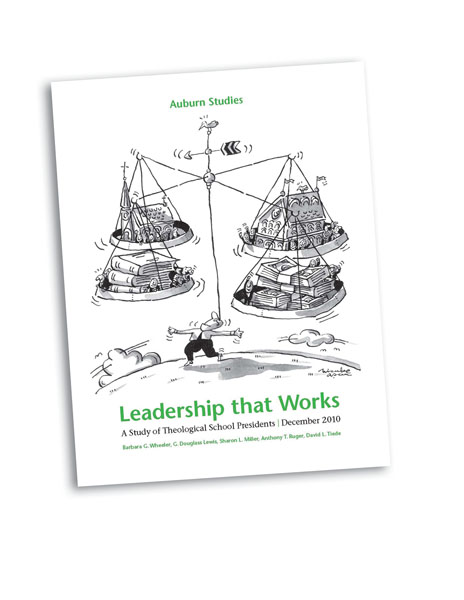Ask any board member of a theological school about the most important duty of the board, and the answer is likely to be hiring the president. How surprising, then, that a recent publication from Auburn Seminary has found major lapses in board leadership in this area at theological schools. The study, issued by Auburn’s Center for the Study of Theological Education and titled Leadership That Works, was previewed in the Spring 2011 issue of In Trust by one of its authors, Barbara G. Wheeler.
 |
| Leadership That Works: A Student of Theological School Presidents, by Barbara G. Wheeler, G. Douglass Lewis, Sharon L. Miller, Anthony T. Ruger, and David L. Tiede (Auburn Seminary Center for the Study of Theological Education, 2010, 32 pp.) Free copies can be ordered at (212) 870-3174. The full report is available in PDF form at https://bit.ly/LeadershipThatWorks. |
The Auburn researchers’ goal was to discover the “ingredients of executive leadership that make institutions both durable and visionary.” While predominately a study of presidents, the conclusions shine a light on the board’s critical role, first in selecting a person whose abilities fit the needs of the school and whose personal qualities align with the character of successful presidents, and then in building a partnership to ensure a successful tenure.
Only a few pages into the study, the authors state that there is no correlation between resume and presidential success. But how then does a board pick a president? Tim Wolfred’s 2009 guide for nonprofits, Managing Executive Transitions, provides a valuable map for traversing the complex, multifaceted, and opportunity-laden road to leadership change.
Managing Executive Transitions presents practices and tools honed by Compasspoint consultants using experience from more than 300 nonprofits, and it is replete with guidelines and tools for every eventuality that may occur in the uncertain terrain of management transition. Wolfred divides the process into three stages: Prepare, Pivot, and Thrive.
Prepare
The “Prepare” stage addresses the too-often-absent “leadership agenda,” an essential but frequently overlooked precursor to the search. “Preparing” means assessing the organization, articulating a vision, and identifying strategic directions for pursuing the vision. Only after a board has completed this foundational work can it begin to consider the type of leader needed for the future, and from this work emerges the “leadership profile.” The notion that vision and strategy are solely the domain of the incoming leader is misguided, and a board that hires a new leader with this expectation markedly increases its risk of hiring the wrong person.
Pivot
 |
| Managing Executive Transitions: A Guide for Nonprofits, by Time Wolfred (Fieldstone Alliance, CompassPoint Nonprofit Services, 2009, 184 pp., $29.95). |
The “Pivot” phase involves the familiar recruiting and selection activities of a presidential search. Here Wolfred provides advice on every step, from creating a mission and vision statement to naming a committee, writing a position description, formulating interview questions, conducting reference checks, and making a final selection. Twenty-eight templates offer proven models for each activity in the cycle.
The Auburn study’s conclusions highlight the complexity of the selection process. One of the study’s conclusions, that “character is a better predictor of executive leaders’ success than credentials and interview performance,” sends a clear signal that there is no simple recipe for a successful search. How does a selection committee discern in a candidate the four characteristics of high-performing presidents uncovered by the Auburn team — personal strength (intelligence, confidence, persuasiveness, and persistence), humility, interpersonal skills, and discipline? How can it predict whether a candidate has the aptitude to master the five core practices of successful presidents — team building, establishing faculty relations that reflect mutual respect, wise financial management, embracing institutional advancement, and discerning a vision for the future? Wolfred offers some advice. For example, his section on behavioral interviewing shows how committees can get beyond superficial fact-finding, and his section on reference checks suggests techniques for eliciting information that will help predict future performance.
Thrive
Widely inadequate or even absent in most theological schools, according to the Auburn study, is attention to the stage that Wolfred calls “Thrive.” Boards worn out from “Preparing” and “Pivoting” sometimes neglect or even fail to recognize the importance of sustained involvement with, and support for, the new executive. Both the Auburn study and Wolfred emphasize that building a partnership between the executive and board is critical to a successful presidency that enables the institution to achieve its goals.
The familiar tasks of orienting and introducing the new president are only the beginning. Strong boards use the “leadership agenda” to set clear performance priorities and establish evaluation procedures. They conduct an initial three-month and then annual reviews that provide candid feedback. They oversee a professional development program for the president that reflects the priorities of the school, and they address problems quickly. These initiatives set the foundation for the successful partnership that underpins a successful presidency.
My brief description of these phases of transition oversimplifies what Wolfred conveys more artfully. Transition management is not linear — it is a multilayered project that calls for strong board leadership on a number of fronts concurrently. While the primary focus may be on the new executive, there are simultaneous responsibilities for assuring a good ending with the departing leader, upgrading capacity according to the needs identified in the strategic review, and attending to the institution’s public face. Perhaps most important is sensitively meeting the needs of the faculty and staff for participation, reassurance, information, and leadership.
There are many variations on this vanilla transition recipe: the sudden departure of a president, the interim executive, choosing consultants, embracing diversity, and dealing with internal candidates. Wolfred offers guidance in all of these areas. It is significant that neither he nor the Auburn Study authors assume the necessity of hiring consultants. Acknowledging that a consultant is a helpful way to delegate the enormous workload but not necessarily an important source of candidates, both books offer sufficient guidance for a board or committee to manage this important work on its own. Indeed, the Auburn report observes that boards heavily involved in these tasks believe that they benefit from the deeper participation in the search process.
Presidential transitions require wholehearted leadership and management by the board in ways both new and unfamiliar. They challenge boards to higher levels of performance in the selection and ongoing support of the president. Taken together, Auburn’s Leadership That Works and Tim Wolfred’s Managing Executive Transitions are a powerful combination that can help boards make the transition an opportunity to renew and strengthen the institutions they serve.
Leadership That Works: A Student of Theological School Presidents, by Barbara G. Wheeler, G. Douglass Lewis, Sharon L. Miller, Anthony T. Ruger, and David L. Tiede (Auburn Seminary Center for the Study of Theological Education, 2010, 32 pp.) Free copies can be ordered at (212) 870-3174. The full report is available in PDF form at https://bit.ly/LeadershipThatWorks.
Managing Executive Transitions: A Guide for Nonprofits, by Time Wolfred (Fieldstone Alliance, CompassPoint Nonprofit Services, 2009, 184 pp., $29.95).




























